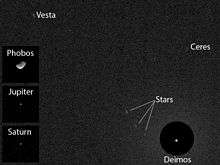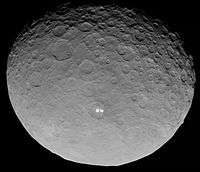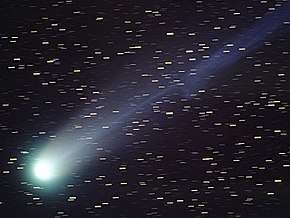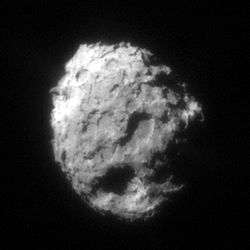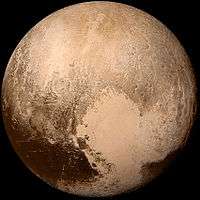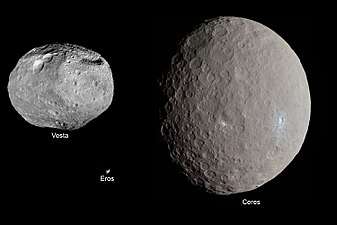Asteroid
Asteroids are minor planets, especially of the inner Solar System. Larger asteroids have also been called planetoids. These terms have historically been applied to any astronomical object orbiting the Sun that did not resolve into a disc in a telescope and was not observed to have characteristics of an active comet such as a tail. As minor planets in the outer Solar System were discovered that were found to have volatile-rich surfaces similar to comets, these came to be distinguished from the objects found in the main asteroid belt.[1]
_mathilde.jpg)
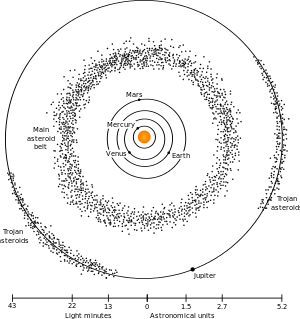
.gif)
In this article, the term "asteroid" refers to the minor planets of the inner Solar System, including those co-orbital with Jupiter.
Overview
Millions of asteroids exist, many the shattered remnants of planetesimals, bodies within the young Sun's solar nebula that never grew large enough to become planets.[2] The vast majority of known asteroids orbit within the main asteroid belt located between the orbits of Mars and Jupiter, or are co-orbital with Jupiter (the Jupiter trojans). However, other orbital families exist with significant populations, including the near-Earth objects. Individual asteroids are classified by their characteristic spectra, with the majority falling into three main groups: C-type, M-type, and S-type. These were named after and are generally identified with carbon-rich, metallic, and silicate (stony) compositions, respectively. The sizes of asteroids varies greatly; the largest, Ceres, is almost 1,000 km (600 mi) across and massive enough to qualify as a dwarf planet.
Asteroids are somewhat arbitrarily differentiated from comets and meteoroids. In the case of comets, the difference is one of composition: while asteroids are mainly composed of mineral and rock, comets are primarily composed of dust and ice. Furthermore, asteroids formed closer to the sun, preventing the development of cometary ice.[3] The difference between asteroids and meteoroids is mainly one of size: meteoroids have a diameter of one meter or less, whereas asteroids have a diameter of greater than one meter.[4] Finally, meteoroids can be composed of either cometary or asteroidal materials.[5]
Only one asteroid, 4 Vesta, which has a relatively reflective surface, is normally visible to the naked eye, and this only in very dark skies when it is favorably positioned. Rarely, small asteroids passing close to Earth may be visible to the naked eye for a short time.[6] As of March 2020, the Minor Planet Center had data on 930,000 minor planets in the inner and outer Solar System, of which about 545,000 had enough information to be given numbered designations.[7]
The United Nations declared 30 June as International Asteroid Day to educate the public about asteroids. The date of International Asteroid Day commemorates the anniversary of the Tunguska asteroid impact over Siberia, Russian Federation, on 30 June 1908.[8][9]
In April 2018, the B612 Foundation reported "It is 100 percent certain we'll be hit [by a devastating asteroid], but we're not 100 percent sure when."[10] Also in 2018, physicist Stephen Hawking, in his final book Brief Answers to the Big Questions, considered an asteroid collision to be the biggest threat to the planet.[11][12][13] In June 2018, the US National Science and Technology Council warned that America is unprepared for an asteroid impact event, and has developed and released the "National Near-Earth Object Preparedness Strategy Action Plan" to better prepare.[14][15][16][17][18] According to expert testimony in the United States Congress in 2013, NASA would require at least five years of preparation before a mission to intercept an asteroid could be launched.[19]
Discovery

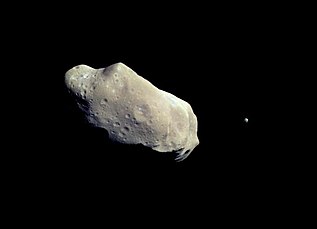
The first asteroid to be discovered, Ceres, was originally considered to be a new planet.[lower-alpha 1] This was followed by the discovery of other similar bodies, which, with the equipment of the time, appeared to be points of light, like stars, showing little or no planetary disc, though readily distinguishable from stars due to their apparent motions. This prompted the astronomer Sir William Herschel to propose the term "asteroid",[lower-alpha 2] coined in Greek as ἀστεροειδής, or asteroeidēs, meaning 'star-like, star-shaped', and derived from the Ancient Greek ἀστήρ astēr 'star, planet'. In the early second half of the nineteenth century, the terms "asteroid" and "planet" (not always qualified as "minor") were still used interchangeably.[lower-alpha 3]
Discovery timeline:[23]
- 10 by 1849
- 100 asteroids by 1868[23]
- 1,000 by 1921[23]
- 10,000 by 1989[23]
- 100,000 by 2005[25]
- 1,000,000 by 2020[7]
Historical methods
Asteroid discovery methods have dramatically improved over the past two centuries.
In the last years of the 18th century, Baron Franz Xaver von Zach organized a group of 24 astronomers to search the sky for the missing planet predicted at about 2.8 AU from the Sun by the Titius-Bode law, partly because of the discovery, by Sir William Herschel in 1781, of the planet Uranus at the distance predicted by the law.[26] This task required that hand-drawn sky charts be prepared for all stars in the zodiacal band down to an agreed-upon limit of faintness. On subsequent nights, the sky would be charted again and any moving object would, hopefully, be spotted. The expected motion of the missing planet was about 30 seconds of arc per hour, readily discernible by observers.
The first object, Ceres, was not discovered by a member of the group, but rather by accident in 1801 by Giuseppe Piazzi, director of the observatory of Palermo in Sicily. He discovered a new star-like object in Taurus and followed the displacement of this object during several nights. Later that year, Carl Friedrich Gauss used these observations to calculate the orbit of this unknown object, which was found to be between the planets Mars and Jupiter. Piazzi named it after Ceres, the Roman goddess of agriculture.[26]
Three other asteroids (2 Pallas, 3 Juno, and 4 Vesta) were discovered over the next few years, with Vesta found in 1807. After eight more years of fruitless searches, most astronomers assumed that there were no more and abandoned any further searches.
However, Karl Ludwig Hencke persisted, and began searching for more asteroids in 1830. Fifteen years later, he found 5 Astraea, the first new asteroid in 38 years. He also found 6 Hebe less than two years later. After this, other astronomers joined in the search and at least one new asteroid was discovered every year after that (except the wartime year 1945). Notable asteroid hunters of this early era were J.R. Hind, A. de Gasparis, R. Luther, H.M.S. Goldschmidt, J. Chacornac, J. Ferguson, N.R. Pogson, E.W. Tempel, J.C. Watson, C.H.F. Peters, A. Borrelly, J. Palisa, the Henry brothers and A. Charlois.
In 1891, Max Wolf pioneered the use of astrophotography to detect asteroids, which appeared as short streaks on long-exposure photographic plates. This dramatically increased the rate of detection compared with earlier visual methods: Wolf alone discovered 248 asteroids, beginning with 323 Brucia, whereas only slightly more than 300 had been discovered up to that point. It was known that there were many more, but most astronomers did not bother with them, some calling them "vermin of the skies",[27] a phrase variously attributed to E. Suess[28] and E. Weiss.[29] Even a century later, only a few thousand asteroids were identified, numbered and named.
Manual methods of the 1900s and modern reporting
Until 1998, asteroids were discovered by a four-step process. First, a region of the sky was photographed by a wide-field telescope, or astrograph. Pairs of photographs were taken, typically one hour apart. Multiple pairs could be taken over a series of days. Second, the two films or plates of the same region were viewed under a stereoscope. Any body in orbit around the Sun would move slightly between the pair of films. Under the stereoscope, the image of the body would seem to float slightly above the background of stars. Third, once a moving body was identified, its location would be measured precisely using a digitizing microscope. The location would be measured relative to known star locations.[30]
These first three steps do not constitute asteroid discovery: the observer has only found an apparition, which gets a provisional designation, made up of the year of discovery, a letter representing the half-month of discovery, and finally a letter and a number indicating the discovery's sequential number (example: 1998 FJ74).
The last step of discovery is to send the locations and time of observations to the Minor Planet Center, where computer programs determine whether an apparition ties together earlier apparitions into a single orbit. If so, the object receives a catalogue number and the observer of the first apparition with a calculated orbit is declared the discoverer, and granted the honor of naming the object subject to the approval of the International Astronomical Union.
Computerized methods
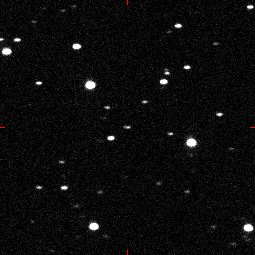
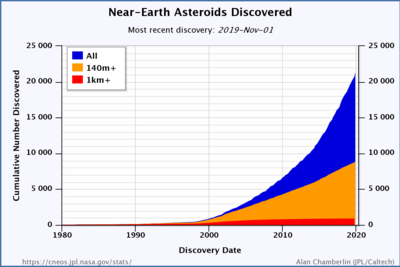
There is increasing interest in identifying asteroids whose orbits cross Earth's, and that could, given enough time, collide with Earth (see Earth-crosser asteroids). The three most important groups of near-Earth asteroids are the Apollos, Amors, and Atens. Various asteroid deflection strategies have been proposed, as early as the 1960s.
The near-Earth asteroid 433 Eros had been discovered as long ago as 1898, and the 1930s brought a flurry of similar objects. In order of discovery, these were: 1221 Amor, 1862 Apollo, 2101 Adonis, and finally 69230 Hermes, which approached within 0.005 AU of Earth in 1937. Astronomers began to realize the possibilities of Earth impact.
Two events in later decades increased the alarm: the increasing acceptance of the Alvarez hypothesis that an impact event resulted in the Cretaceous–Paleogene extinction, and the 1994 observation of Comet Shoemaker-Levy 9 crashing into Jupiter. The U.S. military also declassified the information that its military satellites, built to detect nuclear explosions, had detected hundreds of upper-atmosphere impacts by objects ranging from one to ten meters across.
All these considerations helped spur the launch of highly efficient surveys that consist of charge-coupled device (CCD) cameras and computers directly connected to telescopes. As of 2011, it was estimated that 89% to 96% of near-Earth asteroids one kilometer or larger in diameter had been discovered.[31] A list of teams using such systems includes:[32] [33]
- Lincoln Near-Earth Asteroid Research (LINEAR)
- Near-Earth Asteroid Tracking (NEAT)
- Spacewatch
- Lowell Observatory Near-Earth-Object Search (LONEOS)
- Catalina Sky Survey (CSS)
- Pan-STARRS
- NEOWISE
- Asteroid Terrestrial-impact Last Alert System (ATLAS)
- Campo Imperatore Near-Earth Object Survey (CINEOS)
- Japanese Spaceguard Association
- Asiago-DLR Asteroid Survey (ADAS)
As of 29 October 2018, the LINEAR system alone has discovered 147,132 asteroids.[34] Among all the surveys, 19,266 near-Earth asteroids have been discovered[35] including almost 900 more than 1 km (0.6 mi) in diameter.[36]
Terminology
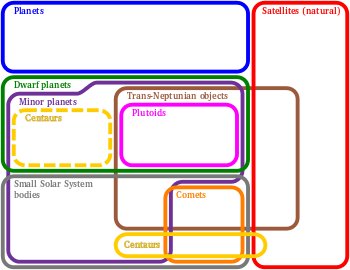
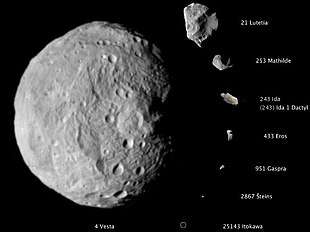
Traditionally, small bodies orbiting the Sun were classified as comets, asteroids, or meteoroids, with anything smaller than one meter across being called a meteoroid. Beech and Steel's 1995 paper proposed a meteoroid definition including size limits.[37][38] The term "asteroid", from the Greek word for "star-like", never had a formal definition, with the broader term minor planet being preferred by the International Astronomical Union.
However, following the discovery of asteroids below ten meters in size, Rubin and Grossman's 2010 paper revised the previous definition of meteoroid to objects between 10 µm and 1 meter in size in order to maintain the distinction between asteroids and meteoroids.[4] The smallest asteroids discovered (based on absolute magnitude H) are 2008 TS26 with {{{1}}} and 2011 CQ1 with {{{1}}} both with an estimated size of about 1 meter.[39]
In 2006, the term "small Solar System body" was also introduced to cover both most minor planets and comets.[40][lower-alpha 4] Other languages prefer "planetoid" (Greek for "planet-like"), and this term is occasionally used in English especially for larger minor planets such as the dwarf planets as well as an alternative for asteroids since they are not star-like.[41] The word "planetesimal" has a similar meaning, but refers specifically to the small building blocks of the planets that existed when the Solar System was forming. The term "planetule" was coined by the geologist William Daniel Conybeare to describe minor planets,[42] but is not in common use. The three largest objects in the asteroid belt, Ceres, Pallas, and Vesta, grew to the stage of protoplanets. Ceres is a dwarf planet, the only one in the inner Solar System.
When found, asteroids were seen as a class of objects distinct from comets, and there was no unified term for the two until "small Solar System body" was coined in 2006. The main difference between an asteroid and a comet is that a comet shows a coma due to sublimation of near surface ices by solar radiation. A few objects have ended up being dual-listed because they were first classified as minor planets but later showed evidence of cometary activity. Conversely, some (perhaps all) comets are eventually depleted of their surface volatile ices and become asteroid-like. A further distinction is that comets typically have more eccentric orbits than most asteroids; most "asteroids" with notably eccentric orbits are probably dormant or extinct comets.[43]
For almost two centuries, from the discovery of Ceres in 1801 until the discovery of the first centaur, Chiron in 1977, all known asteroids spent most of their time at or within the orbit of Jupiter, though a few such as Hidalgo ventured far beyond Jupiter for part of their orbit. Those located between the orbits of Mars and Jupiter were known for many years simply as The Asteroids.[44] When astronomers started finding more small bodies that permanently resided further out than Jupiter, now called centaurs, they numbered them among the traditional asteroids, though there was debate over whether they should be considered asteroids or as a new type of object. Then, when the first trans-Neptunian object (other than Pluto), Albion, was discovered in 1992, and especially when large numbers of similar objects started turning up, new terms were invented to sidestep the issue: Kuiper-belt object, trans-Neptunian object, scattered-disc object, and so on. These inhabit the cold outer reaches of the Solar System where ices remain solid and comet-like bodies are not expected to exhibit much cometary activity; if centaurs or trans-Neptunian objects were to venture close to the Sun, their volatile ices would sublimate, and traditional approaches would classify them as comets and not asteroids.
The innermost of these are the Kuiper-belt objects, called "objects" partly to avoid the need to classify them as asteroids or comets.[45] They are thought to be predominantly comet-like in composition, though some may be more akin to asteroids.[46] Furthermore, most do not have the highly eccentric orbits associated with comets, and the ones so far discovered are larger than traditional comet nuclei. (The much more distant Oort cloud is hypothesized to be the main reservoir of dormant comets.) Other recent observations, such as the analysis of the cometary dust collected by the Stardust probe, are increasingly blurring the distinction between comets and asteroids,[47] suggesting "a continuum between asteroids and comets" rather than a sharp dividing line.[48]
The minor planets beyond Jupiter's orbit are sometimes also called "asteroids", especially in popular presentations.[lower-alpha 5] However, it is becoming increasingly common for the term "asteroid" to be restricted to minor planets of the inner Solar System.[45] Therefore, this article will restrict itself for the most part to the classical asteroids: objects of the asteroid belt, Jupiter trojans, and near-Earth objects.
When the IAU introduced the class small Solar System bodies in 2006 to include most objects previously classified as minor planets and comets, they created the class of dwarf planets for the largest minor planets – those that have enough mass to have become ellipsoidal under their own gravity. According to the IAU, "the term 'minor planet' may still be used, but generally the term 'Small Solar System Body' will be preferred."[49] Currently only the largest object in the asteroid belt, Ceres, at about 975 km (606 mi) across, has been placed in the dwarf planet category.
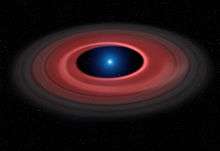
Formation
It is thought that planetesimals in the asteroid belt evolved much like the rest of the solar nebula until Jupiter neared its current mass, at which point excitation from orbital resonances with Jupiter ejected over 99% of planetesimals in the belt. Simulations and a discontinuity in spin rate and spectral properties suggest that asteroids larger than approximately 120 km (75 mi) in diameter accreted during that early era, whereas smaller bodies are fragments from collisions between asteroids during or after the Jovian disruption.[51] Ceres and Vesta grew large enough to melt and differentiate, with heavy metallic elements sinking to the core, leaving rocky minerals in the crust.[52]
In the Nice model, many Kuiper-belt objects are captured in the outer asteroid belt, at distances greater than 2.6 AU. Most were later ejected by Jupiter, but those that remained may be the D-type asteroids, and possibly include Ceres.[53]
Distribution within the Solar System
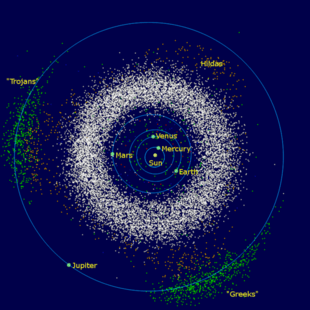
Various dynamical groups of asteroids have been discovered orbiting in the inner Solar System. Their orbits are perturbed by the gravity of other bodies in the Solar System and by the Yarkovsky effect. Significant populations include:
Asteroid belt
The majority of known asteroids orbit within the asteroid belt between the orbits of Mars and Jupiter, generally in relatively low-eccentricity (i.e. not very elongated) orbits. This belt is now estimated to contain between 1.1 and 1.9 million asteroids larger than 1 km (0.6 mi) in diameter,[54] and millions of smaller ones. These asteroids may be remnants of the protoplanetary disk, and in this region the accretion of planetesimals into planets during the formative period of the Solar System was prevented by large gravitational perturbations by Jupiter.
Trojans
Trojans are populations that share an orbit with a larger planet or moon, but do not collide with it because they orbit in one of the two Lagrangian points of stability, L4 and L5, which lie 60° ahead of and behind the larger body. The most significant population of trojans are the Jupiter trojans. Although fewer Jupiter trojans have been discovered (As of 2010), it is thought that they are as numerous as the asteroids in the asteroid belt. Trojans have been found in the orbits of other planets, including Venus, Earth, Mars, Uranus, and Neptune.
Near-Earth asteroids
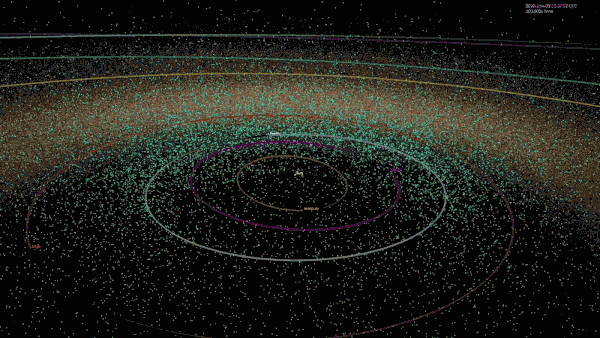
Video (0:55; 23 July 2018)
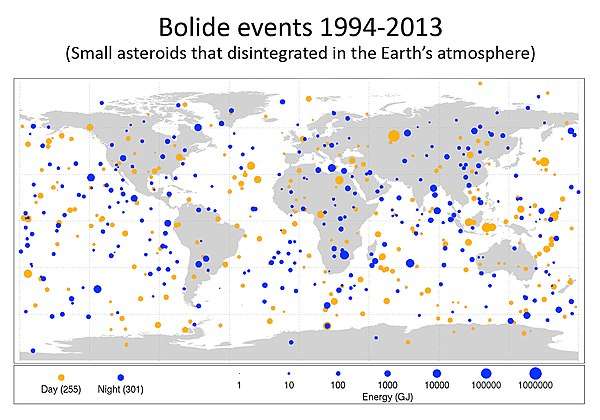
Near-Earth asteroids, or NEAs, are asteroids that have orbits that pass close to that of Earth. Asteroids that actually cross Earth's orbital path are known as Earth-crossers. As of June 2016, 14,464 near-Earth asteroids are known[31] and the number over one kilometer in diameter is estimated to be 900–1,000.
Characteristics
Size distribution
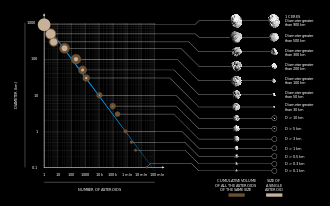
Asteroids vary greatly in size, from almost 1000 km for the largest down to rocks just 1 meter across.[lower-alpha 6] The three largest are very much like miniature planets: they are roughly spherical, have at least partly differentiated interiors,[55] and are thought to be surviving protoplanets. The vast majority, however, are much smaller and are irregularly shaped; they are thought to be either battered planetesimals or fragments of larger bodies.
The dwarf planet Ceres is by far the largest asteroid, with a diameter of 940 km (580 mi). The next largest are 4 Vesta and 2 Pallas, both with diameters of just over 500 km (300 mi). Vesta is the only main-belt asteroid that can, on occasion, be visible to the naked eye. On some rare occasions, a near-Earth asteroid may briefly become visible without technical aid; see 99942 Apophis.
The mass of all the objects of the asteroid belt, lying between the orbits of Mars and Jupiter, is estimated to be in the range of (2.8–3.2)×1021 kg, about 4% of the mass of the Moon. Of this, Ceres comprises 0.938×1021 kg, about a third of the total. Adding in the next three most massive objects, Vesta (9%), Pallas (7%), and Hygiea (3%), brings this figure up to half, whereas the three most-massive asteroids after that, 511 Davida (1.2%), 704 Interamnia (1.0%), and 52 Europa (0.9%), constitute only another 3%. The number of asteroids increases rapidly as their individual masses decrease.
The number of asteroids decreases markedly with size. Although this generally follows a power law, there are 'bumps' at 5 km and 100 km, where more asteroids than expected from a logarithmic distribution are found.[56]
| Approximate number of asteroids (N) larger than a certain diameter (D) | ||||||||||||||
|---|---|---|---|---|---|---|---|---|---|---|---|---|---|---|
| D | 0.1 km | 0.3 km | 0.5 km | 1 km | 3 km | 5 km | 10 km | 30 km | 50 km | 100 km | 200 km | 300 km | 500 km | 900 km |
| N | 25000000 | 4000000 | 2000000 | 750000 | 200000 | 90000 | 10000 | 1100 | 600 | 200 | 30 | 5 | 3 | 1 |
Largest asteroids

Although their location in the asteroid belt excludes them from planet status, the three largest objects, Ceres, Vesta, and Pallas, are intact protoplanets that share many characteristics common to planets, and are atypical compared to the majority of irregularly shaped asteroids. The fourth largest asteroid, Hygiea, appears nearly spherical although it may have an undifferentiated interior, like the majority of asteroids. Between them, the four largest asteroids constitute half the mass of the asteroid belt.
Ceres is the only asteroid with a fully ellipsoidal shape and hence the only one that is a dwarf planet.[40] It has a much higher absolute magnitude than the other asteroids, of around 3.32,[57] and may possess a surface layer of ice.[58] Like the planets, Ceres is differentiated: it has a crust, a mantle and a core.[58] No meteorites from Ceres have been found on Earth.
Vesta, too, has a differentiated interior, though it formed inside the Solar System's frost line, and so is devoid of water;[59][60] its composition is mainly of basaltic rock with minerals such as olivine.[61] Aside from the large crater at its southern pole, Rheasilvia, Vesta also has an ellipsoidal shape. Vesta is the parent body of the Vestian family and other V-type asteroids, and is the source of the HED meteorites, which constitute 5% of all meteorites on Earth.
Pallas is unusual in that, like Uranus, it rotates on its side, with its axis of rotation tilted at high angles to its orbital plane.[62] Its composition is similar to that of Ceres: high in carbon and silicon, and perhaps partially differentiated.[63] Pallas is the parent body of the Palladian family of asteroids.
Hygiea is the largest carbonaceous asteroid[64] and, unlike the other largest asteroids, lies relatively close to the plane of the ecliptic.[65] It is the largest member and presumed parent body of the Hygiean family of asteroids. Because there is no sufficiently large crater on the surface to be the source of that family, as there is on Vesta, it is thought that Hygiea may have been completely disrupted in the collision that formed the Hygiean family, and recoalesced after losing a bit less than 2% of its mass. Observations taken with the Very Large Telescope's SPHERE imager in 2017 and 2018, and announced in late 2019, revealed that Hygiea has a nearly spherical shape, which is at consistent both with it being in hydrostatic equilibrium (and thus a dwarf planet), or formerly being in hydrostatic equilibrium, or with being disrupted and recoalescing.[66][67]
| Attributes of largest asteroids | ||||||||||||
|---|---|---|---|---|---|---|---|---|---|---|---|---|
| Name | Orbital radius (AU) |
Orbital period (years) |
Inclination to ecliptic |
Orbital eccentricity |
Diameter (km) |
Diameter (% of Moon) |
Mass (×1018 kg) |
Mass (% of Ceres) |
Density (g/cm3) |
Rotation period (hr) | ||
| Ceres | 2.77 | 4.60 | 10.6° | 0.079 | 964×964×892 (mean 939.4) |
27% | 938 | 100% | 2.16±0.01 | 9.07 | ||
| Vesta | 2.36 | 3.63 | 7.1° | 0.089 | 573×557×446 (mean 525.4) |
15% | 259 | 28% | 3.46 ± 0.04 | 5.34 | ||
| Pallas | 2.77 | 4.62 | 34.8° | 0.231 | 550×516×476 (mean 512±6) |
15% | 201±13 | 21% | 2.57±0.19 | 7.81 | ||
| Hygiea | 3.14 | 5.56 | 3.8° | 0.117 | 450×430×424 (mean 434±14) |
12% | 83±8 | 9% | 1.94±0.19 | 13.8 | ||
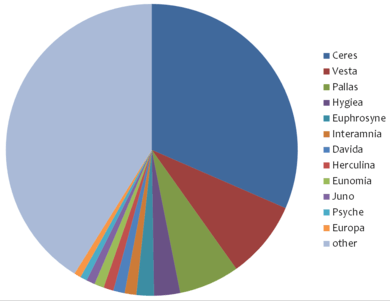
|
1 Ceres 4 Vesta 2 Pallas 10 Hygiea |
31 Euphrosyne 704 Interamnia 511 Davida 532 Herculina |
15 Eunomia 3 Juno 16 Psyche 52 Europa all others |
Rotation
Measurements of the rotation rates of large asteroids in the asteroid belt show that there is an upper limit. Very few asteroids with a diameter larger than 100 meters have a rotation period smaller than 2.2 hours.[70] For asteroids rotating faster than approximately this rate, the inertial force at the surface is greater than the gravitational force, so any loose surface material would be flung out. However, a solid object should be able to rotate much more rapidly. This suggests that most asteroids with a diameter over 100 meters are rubble piles formed through accumulation of debris after collisions between asteroids.[71]
Composition
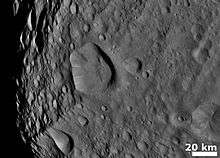
The physical composition of asteroids is varied and in most cases poorly understood. Ceres appears to be composed of a rocky core covered by an icy mantle, where Vesta is thought to have a nickel-iron core, olivine mantle, and basaltic crust.[72] 10 Hygiea, however, which appears to have a uniformly primitive composition of carbonaceous chondrite, is thought to be the largest undifferentiated asteroid. Most of the smaller asteroids are thought to be piles of rubble held together loosely by gravity, though the largest are probably solid. Some asteroids have moons or are co-orbiting binaries: Rubble piles, moons, binaries, and scattered asteroid families are thought to be the results of collisions that disrupted a parent asteroid, or, possibly, a planet.[73]
Asteroids contain traces of amino acids and other organic compounds, and some speculate that asteroid impacts may have seeded the early Earth with the chemicals necessary to initiate life, or may have even brought life itself to Earth (also see panspermia).[74][75] In August 2011, a report, based on NASA studies with meteorites found on Earth, was published suggesting DNA and RNA components (adenine, guanine and related organic molecules) may have been formed on asteroids and comets in outer space.[76][77][78]
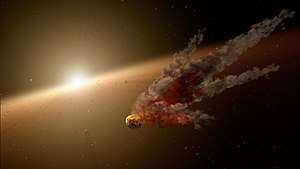
Composition is calculated from three primary sources: albedo, surface spectrum, and density. The last can only be determined accurately by observing the orbits of moons the asteroid might have. So far, every asteroid with moons has turned out to be a rubble pile, a loose conglomeration of rock and metal that may be half empty space by volume. The investigated asteroids are as large as 280 km in diameter, and include 121 Hermione (268×186×183 km), and 87 Sylvia (384×262×232 km). Only half a dozen asteroids are larger than 87 Sylvia, though none of them have moons; however, some smaller asteroids are thought to be more massive, suggesting they may not have been disrupted, and indeed 511 Davida, the same size as Sylvia to within measurement error, is estimated to be two and a half times as massive, though this is highly uncertain. The fact that such large asteroids as Sylvia can be rubble piles, presumably due to disruptive impacts, has important consequences for the formation of the Solar System: Computer simulations of collisions involving solid bodies show them destroying each other as often as merging, but colliding rubble piles are more likely to merge. This means that the cores of the planets could have formed relatively quickly.[79]
On 7 October 2009, the presence of water ice was confirmed on the surface of 24 Themis using NASA's Infrared Telescope Facility. The surface of the asteroid appears completely covered in ice. As this ice layer is sublimating, it may be getting replenished by a reservoir of ice under the surface. Organic compounds were also detected on the surface.[80][81][82][83] Scientists hypothesize that some of the first water brought to Earth was delivered by asteroid impacts after the collision that produced the Moon. The presence of ice on 24 Themis supports this theory.[82]
In October 2013, water was detected on an extrasolar body for the first time, on an asteroid orbiting the white dwarf GD 61.[84] On 22 January 2014, European Space Agency (ESA) scientists reported the detection, for the first definitive time, of water vapor on Ceres, the largest object in the asteroid belt.[85] The detection was made by using the far-infrared abilities of the Herschel Space Observatory.[86] The finding is unexpected because comets, not asteroids, are typically considered to "sprout jets and plumes". According to one of the scientists, "The lines are becoming more and more blurred between comets and asteroids."[86]
In May 2016, significant asteroid data arising from the Wide-field Infrared Survey Explorer and NEOWISE missions have been questioned.[87][88][89] Although the early original criticism had not undergone peer review,[90] a more recent peer-reviewed study was subsequently published.[91][18]
In November 2019, scientists reported detecting, for the first time, sugar molecules, including ribose, in meteorites, suggesting that chemical processes on asteroids can produce some fundamentally essential bio-ingredients important to life, and supporting the notion of an RNA world prior to a DNA-based origin of life on Earth, and possibly, as well, the notion of panspermia.[92][93]
Surface features
Most asteroids outside the "big four" (Ceres, Pallas, Vesta, and Hygiea) are likely to be broadly similar in appearance, if irregular in shape. 50 km (31 mi) 253 Mathilde is a rubble pile saturated with craters with diameters the size of the asteroid's radius, and Earth-based observations of 300 km (186 mi) 511 Davida, one of the largest asteroids after the big four, reveal a similarly angular profile, suggesting it is also saturated with radius-size craters.[94] Medium-sized asteroids such as Mathilde and 243 Ida that have been observed up close also reveal a deep regolith covering the surface. Of the big four, Pallas and Hygiea are practically unknown. Vesta has compression fractures encircling a radius-size crater at its south pole but is otherwise a spheroid. Ceres seems quite different in the glimpses Hubble has provided, with surface features that are unlikely to be due to simple craters and impact basins, but details will be expanded with the Dawn spacecraft, which entered Ceres orbit on 6 March 2015.[95]
Color
Asteroids become darker and redder with age due to space weathering.[96] However evidence suggests most of the color change occurs rapidly, in the first hundred thousands years, limiting the usefulness of spectral measurement for determining the age of asteroids.[97]
Classification
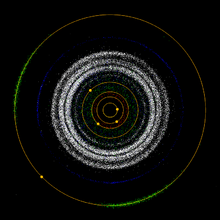
Asteroids are commonly categorized according to two criteria: the characteristics of their orbits, and features of their reflectance spectrum.
Orbital classification
Many asteroids have been placed in groups and families based on their orbital characteristics. Apart from the broadest divisions, it is customary to name a group of asteroids after the first member of that group to be discovered. Groups are relatively loose dynamical associations, whereas families are tighter and result from the catastrophic break-up of a large parent asteroid sometime in the past.[98] Families are more common and easier to identify within the main asteroid belt, but several small families have been reported among the Jupiter trojans.[99] Main belt families were first recognized by Kiyotsugu Hirayama in 1918 and are often called Hirayama families in his honor.
About 30–35% of the bodies in the asteroid belt belong to dynamical families each thought to have a common origin in a past collision between asteroids. A family has also been associated with the plutoid dwarf planet Haumea.
Quasi-satellites and horseshoe objects
Some asteroids have unusual horseshoe orbits that are co-orbital with Earth or some other planet. Examples are 3753 Cruithne and 2002 AA29. The first instance of this type of orbital arrangement was discovered between Saturn's moons Epimetheus and Janus.
Sometimes these horseshoe objects temporarily become quasi-satellites for a few decades or a few hundred years, before returning to their earlier status. Both Earth and Venus are known to have quasi-satellites.
Such objects, if associated with Earth or Venus or even hypothetically Mercury, are a special class of Aten asteroids. However, such objects could be associated with outer planets as well.
Spectral classification
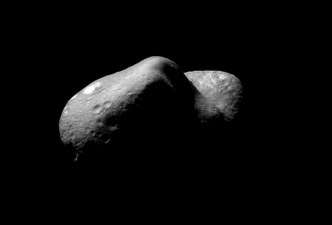
In 1975, an asteroid taxonomic system based on color, albedo, and spectral shape was developed by Chapman, Morrison, and Zellner.[100] These properties are thought to correspond to the composition of the asteroid's surface material. The original classification system had three categories: C-types for dark carbonaceous objects (75% of known asteroids), S-types for stony (silicaceous) objects (17% of known asteroids) and U for those that did not fit into either C or S. This classification has since been expanded to include many other asteroid types. The number of types continues to grow as more asteroids are studied.
The two most widely used taxonomies now used are the Tholen classification and SMASS classification. The former was proposed in 1984 by David J. Tholen, and was based on data collected from an eight-color asteroid survey performed in the 1980s. This resulted in 14 asteroid categories.[101] In 2002, the Small Main-Belt Asteroid Spectroscopic Survey resulted in a modified version of the Tholen taxonomy with 24 different types. Both systems have three broad categories of C, S, and X asteroids, where X consists of mostly metallic asteroids, such as the M-type. There are also several smaller classes.[102]
The proportion of known asteroids falling into the various spectral types does not necessarily reflect the proportion of all asteroids that are of that type; some types are easier to detect than others, biasing the totals.
Problems
Originally, spectral designations were based on inferences of an asteroid's composition.[103] However, the correspondence between spectral class and composition is not always very good, and a variety of classifications are in use. This has led to significant confusion. Although asteroids of different spectral classifications are likely to be composed of different materials, there are no assurances that asteroids within the same taxonomic class are composed of the same (or similar) materials.
Naming
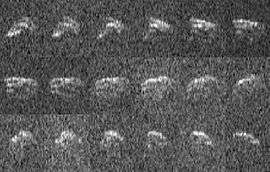
A newly discovered asteroid is given a provisional designation (such as 2002 AT4) consisting of the year of discovery and an alphanumeric code indicating the half-month of discovery and the sequence within that half-month. Once an asteroid's orbit has been confirmed, it is given a number, and later may also be given a name (e.g. 433 Eros). The formal naming convention uses parentheses around the number – e.g. (433) Eros – but dropping the parentheses is quite common. Informally, it is common to drop the number altogether, or to drop it after the first mention when a name is repeated in running text.[104] In addition, names can be proposed by the asteroid's discoverer, within guidelines established by the International Astronomical Union.[105]
Symbols
The first asteroids to be discovered were assigned iconic symbols like the ones traditionally used to designate the planets. By 1855 there were two dozen asteroid symbols, which often occurred in multiple variants.[106]
| Asteroid | Symbol | Year | |
|---|---|---|---|
| 1 Ceres | ⚳ | Ceres' scythe, reversed to double as the letter C | 1801 |
| 2 Pallas | ⚴ | Athena's (Pallas') spear | 1801 |
| 3 Juno | ⚵ | A star mounted on a scepter, for Juno, the Queen of Heaven | 1804 |
| 4 Vesta | ⚶ | The altar and sacred fire of Vesta | 1807 |
| 5 Astraea | A scale, or an inverted anchor, symbols of justice | 1845 | |
| 6 Hebe | Hebe's cup | 1847 | |
| 7 Iris | A rainbow (iris) and a star | 1847 | |
| 8 Flora | A flower (flora), specifically the Rose of England | 1847 | |
| 9 Metis | The eye of wisdom and a star | 1848 | |
| 10 Hygiea | Hygiea's serpent and a star, or the Rod of Asclepius | 1849 | |
| 11 Parthenope | A harp, or a fish and a star; symbols of the sirens | 1850 | |
| 12 Victoria | The laurels of victory and a star | 1850 | |
| 13 Egeria | A shield, symbol of Egeria's protection, and a star | 1850 | |
| 14 Irene | A dove carrying an olive branch (symbol of irene 'peace') with a star on its head,[107] or an olive branch, a flag of truce, and a star | 1851 | |
| 15 Eunomia | A heart, symbol of good order (eunomia), and a star | 1851 | |
| 16 Psyche | A butterfly's wing, symbol of the soul (psyche), and a star | 1852 | |
| 17 Thetis | A dolphin, symbol of Thetis, and a star | 1852 | |
| 18 Melpomene | The dagger of Melpomene, and a star | 1852 | |
| 19 Fortuna | The wheel of fortune and a star | 1852 | |
| 26 Proserpina | Proserpina's pomegranate | 1853 | |
| 28 Bellona | Bellona's whip and lance[108] | 1854 | |
| 29 Amphitrite | The shell of Amphitrite and a star | 1854 | |
| 35 Leukothea | A lighthouse beacon, symbol of Leucothea[109] | 1855 | |
| 37 Fides | The cross of faith (fides)[110] | 1855 | |
In 1851,[111] after the fifteenth asteroid (Eunomia) had been discovered, Johann Franz Encke made a major change in the upcoming 1854 edition of the Berliner Astronomisches Jahrbuch (BAJ, Berlin Astronomical Yearbook). He introduced a disk (circle), a traditional symbol for a star, as the generic symbol for an asteroid. The circle was then numbered in order of discovery to indicate a specific asteroid (although he assigned ① to the fifth, Astraea, while continuing to designate the first four only with their existing iconic symbols). The numbered-circle convention was quickly adopted by astronomers, and the next asteroid to be discovered (16 Psyche, in 1852) was the first to be designated in that way at the time of its discovery. However, Psyche was given an iconic symbol as well, as were a few other asteroids discovered over the next few years (see chart above). 20 Massalia was the first asteroid that was not assigned an iconic symbol, and no iconic symbols were created after the 1855 discovery of 37 Fides.[lower-alpha 8] That year Astraea's number was increased to ⑤, but the first four asteroids, Ceres to Vesta, were not listed by their numbers until the 1867 edition. The circle was soon abbreviated to a pair of parentheses, which were easier to typeset and sometimes omitted altogether over the next few decades, leading to the modern convention.[107]
Exploration
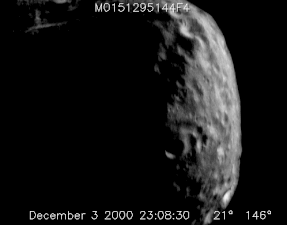
Until the age of space travel, objects in the asteroid belt were merely pinpricks of light in even the largest telescopes and their shapes and terrain remained a mystery. The best modern ground-based telescopes and the Earth-orbiting Hubble Space Telescope can resolve a small amount of detail on the surfaces of the largest asteroids, but even these mostly remain little more than fuzzy blobs. Limited information about the shapes and compositions of asteroids can be inferred from their light curves (their variation in brightness as they rotate) and their spectral properties, and asteroid sizes can be estimated by timing the lengths of star occulations (when an asteroid passes directly in front of a star). Radar imaging can yield good information about asteroid shapes and orbital and rotational parameters, especially for near-Earth asteroids. In terms of delta-v and propellant requirements, NEOs are more easily accessible than the Moon.[112]
The first close-up photographs of asteroid-like objects were taken in 1971, when the Mariner 9 probe imaged Phobos and Deimos, the two small moons of Mars, which are probably captured asteroids. These images revealed the irregular, potato-like shapes of most asteroids, as did later images from the Voyager probes of the small moons of the gas giants.
The first true asteroid to be photographed in close-up was 951 Gaspra in 1991, followed in 1993 by 243 Ida and its moon Dactyl, all of which were imaged by the Galileo probe en route to Jupiter.
The first dedicated asteroid probe was NEAR Shoemaker, which photographed 253 Mathilde in 1997, before entering into orbit around 433 Eros, finally landing on its surface in 2001.
Other asteroids briefly visited by spacecraft en route to other destinations include 9969 Braille (by Deep Space 1 in 1999), and 5535 Annefrank (by Stardust in 2002).
From September to November 2005, the Japanese Hayabusa probe studied 25143 Itokawa in detail and was plagued with difficulties, but returned samples of its surface to Earth on 13 June 2010.
The European Rosetta probe (launched in 2004) flew by 2867 Šteins in 2008 and 21 Lutetia, the third-largest asteroid visited to date, in 2010.
In September 2007, NASA launched the Dawn spacecraft, which orbited 4 Vesta from July 2011 to September 2012, and has been orbiting the dwarf planet 1 Ceres since 2015. 4 Vesta is the second-largest asteroid visited to date.
On 13 December 2012, China's lunar orbiter Chang'e 2 flew within 3.2 km (2 mi) of the asteroid 4179 Toutatis on an extended mission.
The Japan Aerospace Exploration Agency (JAXA) launched the Hayabusa2 probe in December 2014, and plans to return samples from 162173 Ryugu in December 2020.
In June 2018, the US National Science and Technology Council warned that America is unprepared for an asteroid impact event, and has developed and released the "National Near-Earth Object Preparedness Strategy Action Plan" to better prepare.[14][15][16][18]

In September 2016, NASA launched the OSIRIS-REx sample return mission to asteroid 101955 Bennu, which it reached in December 2018. As of June 2019, the probe is in orbit around the asteroid.[113]
Planned and future missions
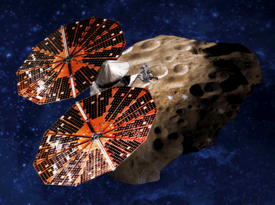
In early 2013, NASA announced the planning stages of a mission to capture a near-Earth asteroid and move it into lunar orbit where it could possibly be visited by astronauts and later impacted into the Moon.[114] On 19 June 2014, NASA reported that asteroid 2011 MD was a prime candidate for capture by a robotic mission, perhaps in the early 2020s.[115]
It has been suggested that asteroids might be used as a source of materials that may be rare or exhausted on Earth (asteroid mining), or materials for constructing space habitats (see Colonization of the asteroids). Materials that are heavy and expensive to launch from Earth may someday be mined from asteroids and used for space manufacturing and construction.
In the U.S. Discovery program the Psyche spacecraft proposal to 16 Psyche and Lucy spacecraft to Jupiter trojans made it to the semi-finalist stage of mission selection.
In January 2017, Lucy and Psyche mission were both selected as NASA's Discovery Program missions 13 and 14 respectively.[116]
Location of Ceres (within asteroid belt) compared to other bodies of the Solar System
Fiction
Asteroids and the asteroid belt are a staple of science fiction stories. Asteroids play several potential roles in science fiction: as places human beings might colonize, resources for extracting minerals, hazards encountered by spacecraft traveling between two other points, and as a threat to life on Earth or other inhabited planets, dwarf planets, and natural satellites by potential impact.
Gallery
 951 Gaspra is the first asteroid to be imaged in close-up, imaged by Galileo on 29 October 1991 (enhanced color)
951 Gaspra is the first asteroid to be imaged in close-up, imaged by Galileo on 29 October 1991 (enhanced color)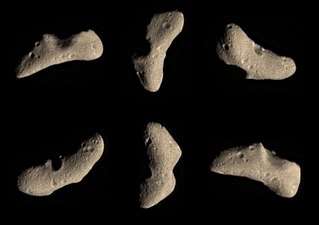 Several views of 433 Eros in natural color, imaged by NEAR on 12 February 2000
Several views of 433 Eros in natural color, imaged by NEAR on 12 February 2000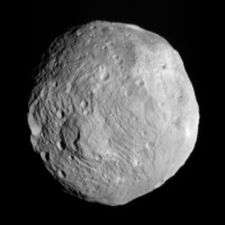 Vesta imaged by Dawn on 9 July 2011
Vesta imaged by Dawn on 9 July 2011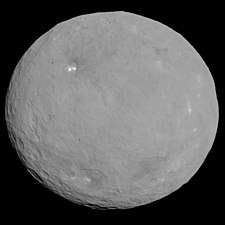
See also
- Active asteroid
- Amor asteroid
- Apollo asteroid
- Asteroid Day
- Asteroid impact avoidance
- Aten asteroid
- Atira asteroid
- BOOTES (Burst Observer and Optical Transient Exploring System)
- Category:Asteroid groups and families
- Category:Asteroids
- Category:Binary asteroids
- Centaur (minor planet)
- Chang'e 2 lunar orbiter
- Constellation program
- Dawn (spacecraft)
- Dwarf planet
- Impact event
- List of asteroid close approaches to Earth
- List of exceptional asteroids
- List of impact craters on Earth
- List of minor planets
- List of minor planets named after people
- List of minor planets named after places
- List of possible impact structures on Earth
- Lost minor planet
- Marco Polo (spacecraft)
- Meanings of minor planet names
- Mesoplanet
- Minor planet
- Near-Earth object
- NEOShield
- NEOSSat (Near Earth Object Surveillance Satellite) Canada's new satellite
- Pioneer 10
- Rosetta (spacecraft)
- ʻOumuamua
Notes
- Ceres is the largest asteroid and is now classified as a dwarf planet. All other asteroids are now classified as small Solar System bodies along with comets, centaurs, and the smaller trans-Neptunian objects.
- In an oral presentation,[20] Clifford Cunningham presented his finding that the word was coined by Charles Burney, Jr., the son of a friend of Herschel,[21][22]
- For example, the Annual of Scientific Discovery. 1871. p. 316 – via Google Books.: "Professor J. Watson has been awarded by the Paris Academy of Sciences, the astronomical prize, Lalande foundation, for the discovery of eight new asteroids in one year. The planet Lydia (No. 110), discovered by M. Borelly at the Marseilles Observatory [...] M. Borelly had previously discovered two planets bearing the numbers 91 and 99 in the system of asteroids revolving between Mars and Jupiter".
The Universal English Dictionary (John Craig, 1869) lists the asteroids (and gives their pronunciations) up to 64 Angelina, along with the definition "one of the recently-discovered planets." At this time it was common to anglicize the spellings of the names, e.g. "Aglaia" for 47 Aglaja and "Atalanta" for 36 Atalante. - The definition of "small Solar System bodies" says that they "include most of the Solar System asteroids, most trans-Neptunian objects, comets, and other small bodies".
- For instance, a joint NASA–JPL public-outreach website states:
"We include Trojans (bodies captured in Jupiter's 4th and 5th Lagrange points), Centaurs (bodies in orbit between Jupiter and Neptune), and trans-Neptunian objects (orbiting beyond Neptune) in our definition of "asteroid" as used on this site, even though they may more correctly be called "minor planets" instead of asteroids."
- Below 1 meter, these are considered to be meteoroids. The definition in the 1995 paper (Beech and Steel) has been updated by a 2010 paper (Rubin and Grossman) and the discovery of 1 meter asteroids.
- The values of Juno and Herculina may be off by as much as 16%, and Euphrosyne by a third. The order of the lower eight may change as better data is acquired, but the values do not overlap with any known asteroid outside these twelve.
- Except for Pluto and, in the astrological community, for a few outer bodies such as 2060 Chiron.
References
- "Asteroids". Jet Propulsion Laboratory. NASA. Retrieved 13 September 2010.
- "What are asteroids and comets?". CNEOS. Frequently Asked Questions (FAQs). Archived from the original on 9 September 2010. Retrieved 13 September 2010.
- "What is the difference between an asteroid and a comet?". Infrared Processing and Analysis Center. Cool Cosmos. Pasadena, CA: California Institute of Technology. Retrieved 13 August 2016.
- Rubin, Alan E.; Grossman, Jeffrey N. (January 2010). "Meteorite and meteoroid: New comprehensive definitions". Meteoritics and Planetary Science. 45 (1): 114–122. Bibcode:2010M&PS...45..114R. doi:10.1111/j.1945-5100.2009.01009.x.
- Atkinson, Nancy (2 June 2015). "What is the difference between asteroids and meteorites?". Universe Today. Retrieved 13 August 2016.
- Britt, Robert Roy (4 February 2005). "Closest flyby of large asteroid to be naked-eye visible". SPACE.com.
- "Latest Published Data". Minor Planet Center. International Astronomical Union. Retrieved 11 March 2020.
- "United Nations General Assembly proclaims 30 June as International Asteroid Day". Office for Outer Space Affairs (Press release). United Nations. 7 December 2016. UNIS/OS/478.
- "International cooperation in the peaceful uses of outer space". United Nations. Rapporteur: Awale Ali Kullane. 25 October 2016. Retrieved 6 December 2016.CS1 maint: others (link)
- Homer, Aaron (28 April 2018). "Earth will be hit by an asteroid with 100 percent certainty, says space-watching group B612". Inquisitr. Retrieved 26 November 2018.
The group of scientists and former astronauts is devoted to defending the planet from a space apocalypse.
- Stanley-Becker, Isaac (15 October 2018). "Stephen Hawking feared race of 'superhumans' able to manipulate their own DNA". The Washington Post. Retrieved 26 November 2018.
- Haldevang, Max de (14 October 2018). "Stephen Hawking left us bold predictions on AI, superhumans, and aliens". Quartz. Retrieved 26 November 2018.
- Bogdan, Dennis (18 June 2018). "Better Way To Avoid Devastating Asteroids Needed?". The New York Times. Retrieved 26 November 2018.
- National Near-Earth Object Preparedness Strategy Action Plan (PDF). White House (Report). 21 June 2018. Retrieved 22 June 2018.
- Mandelbaum, Ryan F. (21 June 2018). "America isn't ready to handle a catastrophic asteroid impact, new report warns". Gizmodo. Retrieved 22 June 2018.
- Myhrvold, Nathan (22 May 2018). "An empirical examination of WISE/NEOWISE asteroid analysis and results". Icarus. 314: 64–97. Bibcode:2018Icar..314...64M. doi:10.1016/j.icarus.2018.05.004.
- Chang, Kenneth (14 June 2018). "Asteroids and adversaries: Challenging what NASA knows about space rocks". The New York Times. Retrieved 26 November 2018.
Two years ago, NASA dismissed and mocked an amateur's criticisms of its asteroids database. Now Nathan Myhrvold is back, and his papers have passed peer review.
- Chang, Kenneth (14 June 2018). "Asteroids and adversaries: Challenging what NASA knows about space rocks". The New York Times. Retrieved 22 June 2018.
- Threats from Space: A review of U.S. Government efforts to track and mitigate asteroids and meteors (PDF) (Report). Hearing before the Committee on Science, Space, and Technology. Part I and Part II. House of Representatives. 19 March 2013. p. 147. Retrieved 26 November 2018.
- HADII Abstracts. HAD Meeting with DPS. Denver, CO. October 2013. Archived from the original on 1 September 2014. Retrieved 14 October 2013.
- Nolin, Robert (8 October 2013). "Local expert reveals who really coined the word 'asteroid'". Sun-Sentinel. Archived from the original on 30 November 2014. Retrieved 10 October 2013.
- Wall, Mike (10 January 2011). "Who really invented the word 'Asteroid' for space rocks?". SPACE.com. Retrieved 10 October 2013.
- Simoes, Christian. "List of asteroids classified by size". www.astronoo.com. Retrieved 7 November 2018.
- "Discovery of Neptune". earthsky.org. Today in Science. Retrieved 13 November 2018.
- Tichá, Jana; Marsden, Brian G.; Bowell, Edward L.G.; Williams, Iwan P.; Marsden, Brian G.; Green, Daniel W.E.; et al. (2009). "Division III / Working Group Committee on Small Bodies Nomenclature". Proceedings of the International Astronomical Union. 4 (T27A): 187–189. Bibcode:2009IAUTA..27..187T. doi:10.1017/S1743921308025489. ISSN 1743-9213.
- McCall, Gerald J.H.; Bowden, A.J.; Howarth, Richard J. (2006). The History of Meteoritics and Key Meteorite Collections: Fireballs, Falls and Finds. Geological Society of London. ISBN 978-1-86239-194-9 – via Google Books.
- Friedman, Lou. "Vermin of the Sky". The Planetary Society.
- Hale, George E. (1916). "Some Reflections on the Progress of Astrophysics". Popular Astronomy. Address at the semi-centennial of the Dearborn Observatory. Vol. 24. pp. 550–558 [555]. Bibcode:1916PA.....24..550H.
- Seares, Frederick H. (1930). "Address of the Retiring President of the Society in Awarding the Bruce Medal to Professor Max Wolf". Publications of the Astronomical Society of the Pacific. 42 (245): 5–22 [10]. Bibcode:1930PASP...42....5S. doi:10.1086/123986.
- Chapman, Mary G. (17 May 1992). "Carolyn Shoemaker, planetary astronomer and most successful 'comet hunter' to date". Astrogeology. USGS. Retrieved 15 April 2008.
- "Discovery Statistics". CNEOS. Retrieved 15 June 2016.
- Yeomans, Don. "Near Earth Object Search Programs". NASA. Archived from the original on 24 April 2008. Retrieved 15 April 2008.
- "Statistics by Survey (all)". Jet Propulsion Laboratory. Discovery Statistics. NASA. 27 December 2018. Archived from the original on 28 December 2018. Retrieved 27 December 2018.
- "Minor Planet Discover Sites". Minor Planet Center. International Astronomical Union. Retrieved 27 December 2018.
- "Unusual Minor Planets". Minor Planet Center. International Astronomical Union. Retrieved 27 December 2018.
- "Cumulative Totals". Jet Propulsion Laboratory. Discovery Statistics. NASA. 20 December 2018. Retrieved 27 December 2018.
- Beech, M.; Steel, D. (September 1995). "On the definition of the term meteoroid". Quarterly Journal of the Royal Astronomical Society. 36 (3): 281–284. Bibcode:1995QJRAS..36..281B.
Meteoroid: A solid object moving in space, with a size less than 10 m, but larger than 100 μm.
- Czechowski, L. (2006). "Planetology and classification of the solar system bodies". Adv. Space Res. 38 (9): 2054–2059. Bibcode:2006AdSpR..38.2054C. doi:10.1016/j.asr.2006.09.004.
- "2011 CQ1". Jet Propulsion Laboratory. JPL Small-Body Database browser (2011-02-04 last obs). NASA.
- "The final IAU resolution on the definition of "planet" ready for voting" (Press release). International Astronomical Union. 24 August 2006. Retrieved 2 March 2007.
- Chaisson, E.J. "Solar System modeling". Center for Astronomy. Harvard University. Retrieved 9 April 2016.
- "Meaning of Planetule". Hyper-dictionary. Retrieved 15 April 2008.
- Weissman, Paul R.; Bottke, William F. Jr.; Levinson, Harold F. (2002). "Evolution of Comets into Asteroids" (PDF). Planetary Science Directorate. Southwest Research Institute. Retrieved 3 August 2010.
- Eglinton, D.; Eglinton, A.C. (16 June 1932). "The Asteroids". The Queenslander. Astronomy (column). Retrieved 25 June 2018.
- "Are Kuiper Belt objects asteroids?". Ask an astronomer. Cornell University. Archived from the original on 3 January 2009.
- Short, Nicholas M., Sr. "Asteroids and Comets". Goddard Space Flight Center. NASA. Archived from the original on 25 September 2008.
- Comet dust seems more ‘asteroidy’. Scientific American (audio podcast). 25 January 2008.
- "Comet samples are surprisingly asteroid-like". New Scientist. 24 January 2008.
- "Pluto". Questions and Answers on Planets. International Astrophysical Union.
- "The glowing halo of a zombie star". European Southern Observatory. Retrieved 16 November 2015.
- Bottke, William F., Jr.; Durda, Daniel D.; Nesvorny, David; Jedicke, Robert; Morbidelli, Alessandro; Vokrouhlicky, David; Levison, Hal (2005). "The fossilized size distribution of the main asteroid belt" (PDF). Icarus. 175 (1): 111. Bibcode:2005Icar..175..111B. doi:10.1016/j.icarus.2004.10.026.
- Kerrod, Robin (2000). Asteroids, Comets, and Meteors. Lerner Publications Co. ISBN 978-0-585-31763-2.
- McKinnon, William; McKinnon, B. (2008). "On The Possibility of Large KBOs Being Injected into The Outer Asteroid Belt". Bulletin of the American Astronomical Society. 40: 464. Bibcode:2008DPS....40.3803M.
- Tedesco, Edward; Metcalfe, Leo (4 April 2002). "New study reveals twice as many asteroids as previously believed" (Press release). European Space Agency. Retrieved 21 February 2008.
- Schmidt, B.; Russell, C.T.; Bauer, J.M.; Li, J.; McFadden, L.A.; Mutchler, M.; et al. (2007). "Hubble Space Telescope Observations of 2 Pallas". Bulletin of the American Astronomical Society. 39: 485. Bibcode:2007DPS....39.3519S.
- Davis, ed. (2002). Asteroids III. cited by Ivezić, Željko (2004). "Lecture 4: Moving objects detected by SDSS" (PDF). Astronomy Department. Lecture notes for ASTR 598. University of Washington. Archived from the original (PDF) on 20 July 2011.
- Parker, J.W.; Stern, S.A.; Thomas, P.C.; Festou, M.C.; Merline, W.J.; Young, E.F.; Binzel, R.P.; Lebofsky, L.A. (2002). "Analysis of the First Disk-resolved Images of Ceres from Ultraviolet Observations with the Hubble Space Telescope". The Astronomical Journal. 123 (1): 549–557. arXiv:astro-ph/0110258. Bibcode:2002AJ....123..549P. doi:10.1086/338093.
- "Asteroid 1 Ceres". The Planetary Society. Archived from the original on 29 September 2007. Retrieved 20 October 2007.
- "Asteroid or mini-planet? Hubble maps the ancient surface of Vesta". Hubble Space Telescope (Press release). Space Telescope Science Institute. 19 April 1995. STScI-1995-20. Retrieved 16 December 2017.
"Key stages in the evolution of the asteroid Vesta". Hubble Space Telescope (Press release). Space Telescope Science Institute. 19 April 1995. Archived from the original on 7 September 2008. Retrieved 20 October 2007. - Russel, C.; Raymond, C.; Fraschetti, T.; Rayman, M.; Polanskey, C.; Schimmels, K.; Joy, S. (2005). "Dawn mission and operations". Proceedings of the International Astronomical Union. 1 (S229): 97–119. Bibcode:2006IAUS..229...97R. doi:10.1017/S1743921305006691.
- Burbine, T.H. (July 1994). "Where are the olivine asteroids in the main belt?". Meteoritics. 29 (4): 453. Bibcode:1994Metic..29..453B.
- Torppa, J.; Kaasalainen, M.; Michałowski, T.; Kwiatkowski, T.; Kryszczyńska, A.; Denchev, P.; Kowalski, R. (1996). "Shapes and rotational properties of thirty asteroids from photometric data". Icarus. 164 (2): 346–383. Bibcode:2003Icar..164..346T. doi:10.1016/S0019-1035(03)00146-5.
- Larson, H.P.; Feierberg, M.A. & Lebofsky, L.A. (1983). "The composition of asteroid 2 Pallas and its relation to primitive meteorites". Icarus. 56 (3): 398. Bibcode:1983Icar...56..398L. doi:10.1016/0019-1035(83)90161-6.
- Barucci, M.A.; et al. (2002). "10 Hygiea: ISO Infrared Observations" (PDF). Icarus. 156 (1): 202–210. Bibcode:2002Icar..156..202B. doi:10.1006/icar.2001.6775. Archived from the original (PDF) on 28 November 2007. Retrieved 21 October 2007.
- "Ceres the Planet". orbitsimulator.com. Archived from the original on 11 October 2007. Retrieved 20 October 2007.
- Vernazza, P.; Jorda, L.; Ševeček, P.; Brož, M.; Viikinkoski, M.; Hanuš, J.; et al. (28 October 2019). "A basin-free spherical shape as an outcome of a giant impact on asteroid Hygiea, Supplementary Information" (PDF). Nature Astronomy. doi:10.1038/s41550-019-0915-8. hdl:10045/103308. Retrieved 30 October 2019.
- Strickland, A. (28 October 2019). "It's an asteroid! No, it's the new smallest dwarf planet in our solar system". CNN. Retrieved 28 October 2019.
- Baer, Jim, ed. (12 December 2010). "Recent asteroid mass determinations". Retrieved 2 September 2011.
- Pitjeva, E.V. (2005). "High-Precision Ephemerides of Planets – EPM and Determination of Some Astronomical Constants" (PDF). Solar System Research. 39 (3): 184. Bibcode:2005SoSyR..39..176P. doi:10.1007/s11208-005-0033-2. Archived from the original (PDF) on 3 July 2014.
- "About Lightcurves". ALCDEF. Asteroid Lightcurve Photometry Database. 4 December 2018. Retrieved 27 December 2018.
- Rossi, Alessandro (20 May 2004). "The mysteries of the asteroid rotation day". The Spaceguard Foundation. Archived from the original on 12 May 2006. Retrieved 9 April 2007.
- "Asteroid or mini-planet? Hubble maps the ancient surface of Vesta". HubbleSite (Press release). News Center / Release Images. Space Telescope Science Institute. 19 April 1995. Retrieved 27 January 2015.
-
Soter, Steven (16 August 2006). "What is a Planet?" (PDF). Retrieved 25 December 2017. Cite journal requires
|journal=(help) - "Life is sweet: Sugar-packing asteroids may have seeded life on Earth". SPACE.com. 19 December 2001. Archived from the original on 24 January 2002.
- Reuell, Peter (8 July 2019). "Harvard study suggests asteroids might play key role in spreading life". Harvard Gazette. Retrieved 26 September 2019.
- Callahan, M.P.; Smith, K.E.; Cleaves, H.J.; Ruzica, J.; Stern, J.C.; Glavin, D.P.; House, C.H.; Dworkin, J.P. (11 August 2011). "Carbonaceous meteorites contain a wide range of extraterrestrial nucleobases". PNAS. 108 (34): 13995–13998. Bibcode:2011PNAS..10813995C. doi:10.1073/pnas.1106493108. PMC 3161613. PMID 21836052.
- Steigerwald, John (8 August 2011). "NASA researchers: DNA building blocks can be made in space" (Press release). NASA. Retrieved 10 August 2011.
- "DNA building blocks can be made in space, NASA evidence suggests". ScienceDaily. 9 August 2011. Retrieved 9 August 2011.
- Descamps, P.; Marchis, F.; Berthier, J.; Emery, J.P.; Duchêne, G.; de Pater, I.; et al. (February 2011). "Triplicity and physical characteristics of asteroid (216) Kleopatra". Icarus. 211 (2): 1022–1033. arXiv:1011.5263. Bibcode:2011Icar..211.1022D. doi:10.1016/j.icarus.2010.11.016.
- Cowen, Ron (8 October 2009). "Ice confirmed on an asteroid". Science News. Archived from the original on 12 October 2009. Retrieved 9 October 2009.
- Atkinson, Nancy (8 October 2009). "More water out there, ice found on an asteroid". International Space Fellowship. Archived from the original on 11 October 2009. Retrieved 11 October 2009.
- Campins, H.; Hargrove, K; Pinilla-Alonso, N.; Howell, E.S.; Kelley, M.S.; Licandro, J.; et al. (2010). "Water ice and organics on the surface of the asteroid 24 Themis". Nature. 464 (7293): 1320–132. Bibcode:2010Natur.464.1320C. doi:10.1038/nature09029. PMID 20428164.
- Rivkin, Andrew S.; Emery, Joshua P. (2010). "Detection of ice and organics on an asteroidal surface". Nature. 464 (7293): 1322–1323. Bibcode:2010Natur.464.1322R. doi:10.1038/nature09028. PMID 20428165.
- Mack, Eric. "Newly spotted wet asteroids point to far-flung Earth-like planets". CNET.
- Küppers, Michael; O'Rourke, Laurence; Bockelée-Morvan, Dominique; Zakharov, Vladimir; Lee, Seungwon; von Allmen, Paul; et al. (2014). "Localized sources of water vapour on the dwarf planet (1) Ceres". Nature. 505 (7484): 525–527. Bibcode:2014Natur.505..525K. doi:10.1038/nature12918. PMID 24451541.
- Harrington, J.D. (22 January 2014). "Herschel Telescope Detects Water on Dwarf Planet" (Press release). NASA. Release 14-021. Retrieved 22 January 2014.
- Myhrvold, Nathan (23 May 2016). "Asteroid thermal modeling in the presence of reflected sunlight with an application to WISE/NEOWISE observational data". Icarus. 303: 91–113. arXiv:1605.06490. Bibcode:2018Icar..303...91M. doi:10.1016/j.icarus.2017.12.024.
- Chang, Kenneth (23 May 2016). "How big are those killer asteroids? A critic says NASA doesn't know". The New York Times. Retrieved 24 May 2016.
- Billings, Lee (27 May 2016). "For asteroid-hunting astronomers, Nathan Myhrvold says the sky is falling". Scientific American. Retrieved 28 May 2016.
- NASA Response to Recent Paper on NEOWISE Asteroid Size Results. NASA Administrator (Report). NASA. 25 May 2016. Retrieved 29 May 2016.
- Myhrvold, Nathan (22 May 2018). "An empirical examination of WISE/NEOWISE asteroid analysis and results". Icarus. 314: 64–97. Bibcode:2018Icar..314...64M. doi:10.1016/j.icarus.2018.05.004.
- Steigerwald, Bill; Jones, Nancy; Furukawa, Yoshihiro (18 November 2019). "First detection of sugars in meteorites gives clues to origin of life" (Press release). NASA. Retrieved 18 November 2019.
- Furukawa, Yoshihiro; et al. (18 November 2019). "Extraterrestrial ribose and other sugars in primitive meteorites". Proceedings of the National Academy of Sciences of the United States of America. 116 (49): 24440–24445. Bibcode:2019PNAS..11624440F. doi:10.1073/pnas.1907169116. PMC 6900709. PMID 31740594.
- Conrad, A.R.; Dumas, C.; Merline, W.J.; Drummonf, J.D.; Campbell, R.D.; Goodrich, R.W.; et al. (2007). "Direct measurement of the size, shape, and pole of 511 Davida with Keck AO in a single night" (PDF). Icarus. 191 (2): 616–627. Bibcode:2007Icar..191..616C. doi:10.1016/j.icarus.2007.05.004. Archived from the original (PDF) on 11 August 2007.
- Boyle, Alan (6 March 2015). "Dawn spacecraft slips quietly into orbit around dwarf planet Ceres". NBCNews.com. NBC Universal Media, LLC. Retrieved 11 March 2015.
- "University of Hawaii astronomer and colleagues find evidence that asteroids change color as they age". Institute for Astronomy (Press release). University of Hawaii. 19 May 2005. Retrieved 27 February 2013.
- Courtland, Rachel (30 April 2009). "Sun damage conceals asteroids' true ages". New Scientist. Retrieved 27 February 2013.
- Zappalà, V.; Bendjoya, Ph.; Cellino, A.; Farinella, P.; Froeschlé, C. (1995). "Asteroid families: Search of a 12,487 asteroid sample using two different clustering techniques". Icarus. 116 (2): 291–314. Bibcode:1995Icar..116..291Z. doi:10.1006/icar.1995.1127.
- Jewitt, David C.; Sheppard, Scott; Porco, Carolyn (2004). "Jupiter's outer satellites and Trojans" (PDF). In Bagenal, F.; Dowling, T.E.; McKinnon, W.B. (eds.). Jupiter: The Planet, Satellites and Magnetosphere. Cambridge University Press.
- Chapman, C.R.; Morrison, David; Zellner, Ben (1975). "Surface properties of asteroids: A synthesis of polarimetry, radiometry, and spectrophotometry". Icarus. 25 (1): 104–130. Bibcode:1975Icar...25..104C. doi:10.1016/0019-1035(75)90191-8.
- Tholen, D.J. (1989). "Asteroid taxonomic classifications". Asteroids II; Proceedings of the Conference. University of Arizona Press. pp. 1139–1150. Bibcode:1989aste.conf.1139T.
- Bus, S.J. (2002). "Phase II of the Small Main-belt Asteroid Spectroscopy Survey: A feature-based taxonomy". Icarus. 158 (1): 146. Bibcode:2002Icar..158..146B. doi:10.1006/icar.2002.6856. S2CID 4880578.
- McSween, Harry Y., Jr. (1999). Meteorites and their Parent Planets (2nd ed.). Oxford University Press. ISBN 978-0-521-58751-8.
- "The Naming of Asteroids". Open Learn. London, UK: The Open University. Retrieved 14 August 2016.
- "Asteroid naming guidelines". The Planetary Society. Retrieved 14 August 2016.
- Gould, B.A. (1852). "On the symbolic notation of the asteroids". Astronomical Journal. 2: 80. Bibcode:1852AJ......2...80G. doi:10.1086/100212.
- Hilton, James L. (17 September 2001). "When did the asteroids become minor planets?". Archived from the original on 6 November 2007. Retrieved 26 March 2006.
- Encke, J.F. (1854). "Beobachtung der Bellona, nebst Nachrichten über die Bilker Sternwarte". Astronomische Nachrichten. 38 (9): 143. Bibcode:1854AN.....38..143.. doi:10.1002/asna.18540380907.
- Luther, R. (1855). "Name und Zeichen des von Herrn R. Luther zu Bilk am 19. April entdeckten Planeten". Astronomische Nachrichten. 40 (24): 373. Bibcode:1855AN.....40Q.373L. doi:10.1002/asna.18550402405.
- Luther, R. (1855). "Schreiben des Herrn Dr. R. Luther, Directors der Sternwarte zu Bilk, an den Herausgeber". Astronomische Nachrichten. 42 (7): 107. Bibcode:1855AN.....42..107L. doi:10.1002/asna.18550420705.
- Hilton, James L. "When did the asteroids become minor planets?". U.S. Naval Observatory. Washington, DC: Naval Meteorology and Oceanography Command. Archived from the original on 6 April 2012. Retrieved 6 November 2011.
- Rob R. Landis; David J. Korsmeyer; Paul A. Abell; Daniel R. Adamo. A piloted Orion flight to a near-Earth object: A feasibility study (PDF). American Institute of Aeronautics and Astronautics (Report).
- "OSIRIS-REx spacecraft captures closest ever image of asteroid Bennu". New Scientist. 18 June 2019. Retrieved 8 September 2019.
- Wall, Mike (30 September 2013). "NASA may slam captured asteroid into Moon (eventually)". SPACE.com.
- Borenstein, Seth (19 June 2014). "Rock that whizzed by Earth may be grabbed by NASA". Excite.com. AP News. Retrieved 20 June 2014.
- Northon, Karen (4 January 2017). "NASA Selects Two Missions to Explore the Early Solar System" (Press release). NASA.
Further reading
Further information about asteroids
- "Logarithmic graph of asteroid discoveries from 1801–2015". (see Logarithmic scale)
- Asteroids (Audio program). In Our Time. BBC Radio 4. 3 November 2005.
discussion with Monica Grady, Carolin Crawford, & John Zarnecki
- Hilton, James L. "When did the asteroids become minor planets?". U.S. Naval Observatory. Washington, DC: United States Navy. Archived from the original on 25 August 2009.
External links
- "Alphabetical list of minor planet names" (ASCII). Minor Planet Center. International Astronomical Union.
- "Asteroid articles in Planetary Science Research Discoveries". Planetary Science. University of Hawaii.
- "Near-Earth Object Segment". ESA Space Situational Awareness.
- "IAU Committee on Small Body Nomenclature". Astronomy Department. University of Maryland. Archived from the original on 3 August 2006.
- "JPL Asteroid Watch site". Jet Propulsion Laboratory. Pasadena, CA: NASA.
- "NASA Asteroid and Comet Watch site".
- "Near Earth Asteroid Tracking (NEAT)". Jet Propulsion Laboratory. Pasadena, CA: NASA. Archived from the original on 24 October 2015.
- "Near Earth Objects dynamic site".
- "Current map of the Solar System". Armagh Observatory. Archived from the original on 19 April 2013.
- "Spaceguard Centre".
- "TECA table of next close approaches to the Earth".
- Asteroid size comparisons (video; 2:40) on YouTube
